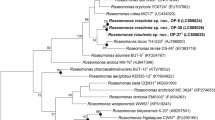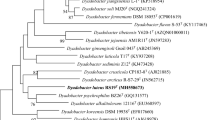Abstract
A Gram-negative, coccobacilli, non-spore forming and non-motile bacterium, designated PN1T, was isolated from a banana leaf collected in Mattra island, Thailand. This isolate was observed to grow optimally at 30 °C and pH 7.0, and to grow with 0–3 % NaCl. Comparative 16S rRNA gene sequence analysis showed that strain PN1T is closely related to members of the genus Roseomonas, exhibiting the highest 16S rRNA gene sequence similarity to Roseomonas aestuarii JC17T (96.5 %). The DNA G + C content of strain PN1T was determined to be 69.7 mol %. Based on physiological and biochemical tests, and genotypic differences between strain PN1T and the validly named species of the genus Roseomonas, it is proposed that the strain be classified as a new species of Roseomonas for which the name Roseomonas musae sp. nov. is proposed. The type strain is PN1T (= BCC 44863T = NBRC 107870T).

Similar content being viewed by others
References
Baik KS, Park SC, Choe HN, Kim SN, Moon JH, Seong CN (2012) Roseomonas riguiloci sp. nov., isolated from wetland freshwater. Int J Syst Evol Microbiol. doi:10.1099/ijs.0.036186-0
Bauer AW, Kirby WMM, Sherris JC, Turck M (1966) Antibiotic susceptibility testing by a standardized single disk method. Am J Clin Pathol 45:493–496
Chanprame S, Todd JJ, Widholm JM (1996) Prevention of pink-pigmented methylotrophic bacteria (Methylobacterium mesophilicum) contamination of plant tissue cultures. Plant Cell Rep 16:222–225
Corpe WA (1985) A method for detecting methylotrophic bacteria on solid surfaces. J Microbiol Meth 3:215–221
Ezaki T, Hashimoto Y, Yabuuchi E (1989) Fluorometric deoxyribonucleic acid-deoxyribonucleic acid hybridization in microdilution wells as an alternative to membrane filter hybridization in which radioisotopes are used to determine genetic relatedness among bacterial strains. Int J Syst Bacteriol 39:224–229
Felsenstein J (1985) Confidence limits on phylogenies: an approach using the bootstrap. Evolution 39:783–791
Furuhata K, Miyamamoto H, Goto K, Kato Y, Hara M, Fukuyama M (2008) Roseomonas stagni sp. nov., isolated from pond water in Japan. J Gen Appl Microbiol 54:167–171
Gallego V, Sanchez-Porro C, Garcia MT, Ventosa A (2006) Roseomonas aquatica sp. nov., isolated from drinking water. Int J Syst Evol Microbiol 56:2291–2295
Hall TA (1999) BioEdit: a user-friendly biological sequence alignment editor and analysis program for Windows 95/98/NT. Nucleic Acids Symp Ser 41:95–98
Han XY, Pham AS, Tarrand JJ, Rolston KV, Helsel LO, Levett PN (2003) Bacteriologic characterization of 36 strains of Roseomonas species and proposal of Roseomonas mucosa sp. nov. and Roseomonas gilardii subsp. rosea subsp. nov. Am J Clin Pathol 120:256–264
Jiang CY, Dai X, Wang BJ, Zhou YG, Liu SJ (2006) Roseomonas lacus sp. nov., isolated from freshwater lake sediment. Int J Syst Evol Microbiol 56:25–28
Katayama-Fujimura Y, Komatsu Y, Kuraishi H, Kaneko T (1984) Estimation of DNA base composition by high performance liquid chromatography of its nuclease P1 hydrolysate. Agric Biol Chem 48:3169–3172
Kim MS, Baik KS, Park SC, Rhee MS, Oh HM, Seong CN (2009) Roseomonas frigidaquae sp. nov., isolated from a water-cooling system. Int J Syst Evol Microbiol 59:1630–1634
Kim OS, Cho YJ, Lee K, Yoon SH, Kim M, Na H, Park SC, Jeon YS, Lee JH, Yi H, Won S, Chun J (2012) Introducing EzTaxon-e: a prokaryotic 16S rRNA gene sequence database with phylotypes that represent uncultured species. Int J Syst Evol Microbiol 62:716–721
Kimura M (1980) A simple method for estimating evolutionary rate of base substitutions through comparative studies of nucleotide sequences. J Mol Evol 16:111–120
Lane DJ (1991) 16S/23S rRNA sequencing. In: Stackebrandt E, Goodfellow M (eds) Nucleic acid techniques in bacterial systematic. John Wiley and Sons, Chichester, pp 115–175
Lopes A, Esp Rito Santo C, Grass G, Chung AP, Morais PV (2011) Roseomonas pecuniae sp. nov., isolated from the surface of a copper-alloy coin. Int J Syst Evol Microbiol 61:610–615
Loreti S, Gallelli A, Simone DDe, Bosco A (2009) Detection of Pseudomonas avellanae and the bacterial microflora of hazelnut affected by ‘MORIA’ in central Italy. J Plant Pathol 2:365–373
Minnikin DE, O’Donnell AG, Goodfellow M, Alderson G, Athalye M, Schaal A, Parlett JH (1984) An ntegrated procedure for the extraction of isoprenoid quinines and polar lipids. J Microbiol Methods 2:233–241
Nei M, Kumar S (2000) Molecular evolution and phylogenetics. Oxford University Press, New York
Ramana VV, Sasikala Ch, Takaichi S, Ramana ChV (2010) Roseomonas aestuarii sp. nov., a bacteriochlorophyll-a containing alphaproteobacterium isolated from an estuarine habitat of India. Syst Appl Microbiol 33:198–203
Rihs JD, Brenner DJ, Weaver RE, Steigerwalt AG, Hollis DG, Yu VL (1993) Roseomonas, a new genus associated with bacteremia and other human infections. J Clin Microbiol 31:3275–3283
Saitou N, Nei M (1987) The neighbor-joining method: a new method for reconstructing phylogenetic trees. Mol Biol Evol 4:406–425
Sanchez-Porro C, Gallego V, Busse HJ, Kampfer P, Ventosa A (2009) Transfer of Teichococcus ludipueritiae and Muricoccus roseus to the genus Roseomonas, as Roseomonas ludipueritiae comb. nov. and Roseomonas rosea comb. nov., respectively, and emended description of the genus Roseomonas. Int J Syst Evol Microbiol 59:1193–1198
Sasser M (1990) Identification of bacteria by gas chromatography of cellular fatty acids. USFCC Newsl 20:1–6
Schaeffer AB, Fulton MD (1933) A simplified method of staining endospores. Science 77:194
Tamura K, Dudley J, Nei M, Kumar S (2007) MEGA4: molecular evolutionary genetics analysis (MEGA) software version 4.0. Mol Biol Evol 24:1596–1599
Thompson JD, Higgins DG, Gibson TJ (1994) CLUSTAL W: improving the sensitivity of progressive multiple sequence alignment through sequence weighting, position-specific gap penalties and weight matrix choice. Nucleic Acids Res 22:4673–4680
Wayne LG, Brenner DJ, Colwell RR, Grimont PAD, Kandler O, Krichevsky MI, Moore LH, Moore WEC, Murray RGE, Stackebrandt E, Starr MP, Truper HG (1987) Report of the ad hoc committee on reconciliation of approaches to bacterial systematics. Int J Syst Bacteriol 37:463–464
Weyant RS, Whitney AM (2005) Roseomonas. In: Brenner DJ, Krieg NR, Staley JT, Garrity GM (eds) Bergey’s manual of systematic bacteriology, part C, vol 2, 2nd edn. Springer, New York, pp 88–92
Yoo SH, Weon HY, Noh HJ, Hong SB, Lee CM, Kim BY, Kwon SW, Go SJ (2008) Roseomonas aerilata sp. nov., isolated from an air sample. Int J Syst Evol Microbiol 58:1482–1485
Yoon JH, Kang SJ, Oh HW, Oh TK (2007) Roseomonas terrae sp. nov. Int J Syst Evol Microbiol 57:2485–2488
Zhang YQ, Yu LY, Wang D, Liu HY, Sun CH, Jiang W, Zhang YQ, Li WJ (2008) Roseomonas vinacea sp. nov., a gram-negative coccobacillus isolated from a soil sample. Int J Syst Evol Microbiol 58:2070–2074
Acknowledgments
This research was supported by the scholarship to promote international publication from Graduate School Kasetsart University to P. Nutaratat. This work was also supported by the Higher Education Research Promotion and National Research University Project of Thailand, Office of the Higher Education Commission. The authors would also like to thank Professor J. P. Euzéby for advice on naming the species.
Author information
Authors and Affiliations
Corresponding author
Electronic supplementary material
Below is the link to the electronic supplementary material.
Rights and permissions
About this article
Cite this article
Nutaratat, P., Srisuk, N., Duangmal, K. et al. Roseomonas musae sp. nov., a new bacterium isolated from a banana phyllosphere. Antonie van Leeuwenhoek 103, 617–624 (2013). https://doi.org/10.1007/s10482-012-9845-5
Received:
Accepted:
Published:
Issue Date:
DOI: https://doi.org/10.1007/s10482-012-9845-5




